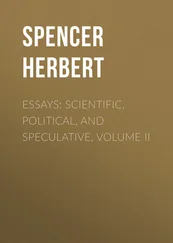Observations showing that as we descend below the Earth's surface there is a progressive increase of heat, joined with the conspicuous evidence furnished by volcanoes, necessitate the conclusion that the temperature is very high at great depths. Whether, as some believe, the interior of the Earth is still molten, or whether, as Sir William Thomson contends, it must be solid; there is agreement in the inference that its heat is intense. And it has been further shown that the rate at which the temperature increases on descending below the surface, is such as would be found in a mass which had been cooling for an indefinite period. The Moon, too, shows us, by its corrugations and its conspicuous extinct volcanoes, that in it there has been a process of refrigeration and contraction, like that which has gone on in the Earth. There is no teleological explanation of these facts. The frequent destructions of life by earthquakes and volcanoes, imply, rather, that it would have been better had the Earth been created with a low internal temperature. But if we contemplate the facts in connexion with the Nebular Hypothesis, we see that this still-continued high internal heat is one of its corollaries. The Earth must have passed through the gaseous and the molten conditions before it became solid, and must for an almost infinite period by its internal heat continue to bear evidence of this origin.
The group of giant planets furnishes remarkable evidence. The a priori inference drawn above, that great size joined with relatively high ratio of centrifugal force to gravity must greatly retard aggregation, and must thus, by checking the genesis and dissipation of heat, make the process of cooling a slow one, has of late years received verifications from inferences drawn a posteriori ; so that now the current conclusion among astronomers is that in physical condition the great planets are in stages midway between that of the Earth and that of the Sun. The fact that the centre of Jupiter's disc is twice or thrice as bright as his periphery, joined with the facts that he seems to radiate more light than is accounted for by reflection of the Sun's rays, and that his spectrum shows the "red-star line", are taken as evidences of luminosity; while the immense and rapid perturbations in his atmosphere, far greater than could be caused by heat received from the Sun, as well as the formation of spots analogous to those of the Sun, which also, like those of the Sun, show a higher rate of rotation near the equator than further from it, are held to imply high internal temperature. Thus in Jupiter, as also in Saturn, we find states which, not admitting of any teleological explanations (for they manifestly exclude the possibility of life), admit of explanations derived from the Nebular Hypothesis.
But the argument from temperature does not end here. There remains to be noticed a more conspicuous and still more significant fact. If the Solar System was produced by the concentration of diffused matter, which evolved heat while gravitating into its present dense form; then there is an obvious implication. Other things equal, the latest-formed mass will be the latest in cooling—will, for an almost infinite time, possess a greater heat than the earlier-formed ones. Other things equal, the largest mass will, because of its superior aggregative force, become hotter than the others, and radiate more intensely. Other things equal, the largest mass, notwithstanding the higher temperature it reaches, will, in consequence of its relatively small surface, be the slowest in losing its evolved heat. And hence, if there is one mass which was not only formed after the rest, but exceeds them enormously in size, it follows that this one will reach an intensity of incandescence far beyond that reached by the rest; and will continue in a state of intense incandescence long after the rest have cooled. Such a mass we have in the Sun. It is a corollary from the Nebular Hypothesis, that the matter forming the Sun assumed its present integrated shape at a period much more recent than that at which the planets became definite bodies. The quantity of matter contained in the Sun is nearly five million times that contained in the smallest planet, and above a thousand times that contained in the largest. And while, from the enormous gravitative force of his parts to their common centre, the evolution of heat has been intense, the facilities of radiation have been relatively small. Hence the still-continued high temperature. Just that condition of the central body which is a necessary inference from the Nebular Hypothesis, we find actually existing in the Sun.
[The paragraph which here follows, though it contains some questionable propositions, I reproduce just as it stood when first published in 1858, for reasons which will presently be apparent.]
It may be well to consider more closely, what is the probable condition of the Sun's surface. Round the globe of incandescent molten substances, thus conceived to form the visible body of the Sun [which in conformity with the argument in a previous section, now transferred to the Addenda, was inferred to be hollow and filled with gaseous matter at high tension] there is known to exist a voluminous atmosphere: the inferior brilliancy of the Sun's border, and the appearances during a total eclipse, alike show this. What now must be the constitution of this atmosphere? At a temperature approaching a thousand times that of molten iron, which is the calculated temperature of the solar surface, very many, if not all, of the substances we know as solid, would become gaseous; and though the Sun's enormous attractive force must be a powerful check on this tendency to assume the form of vapour, yet it cannot be questioned that if the body of the Sun consists of molten substances, some of them must be constantly undergoing evaporation. That the dense gases thus continually being generated will form the entire mass of the solar atmosphere, is not probable. If anything is to be inferred, either from the Nebular Hypothesis, or from the analogies supplied by the planets, it must be concluded that the outermost part of the solar atmosphere consists of what are called permanent gases—gases that are not condensible into fluid even at low temperatures. If we consider what must have been the state of things here, when the surface of the Earth was molten, we shall see that round the still molten surface of the Sun, there probably exists a stratum of dense aeriform matter, made up of sublimed metals and metallic compounds, and above this a stratum of comparatively rare medium analogous to air. What now will happen with these two strata? Did they both consist of permanent gases, they could not remain separate: according to a well-known law, they would eventually form a homogeneous mixture. But this will by no means happen when the lower stratum consists of matters that are gaseous only at excessively high temperatures. Given off from a molten surface, ascending, expanding, and cooling, these will presently reach a limit of elevation above which they cannot exist as vapour, but must condense and precipitate. Meanwhile the upper stratum, habitually charged with its quantum of these denser matters, as our air with its quantum of water, and ready to deposit them on any depression of temperature, must be habitually unable to take up any more of the lower stratum; and therefore this lower stratum will remain quite distinct from it. [20]
Considered in their ensemble , the several groups of evidences assigned amount almost to proof. We have seen that, when critically examined, the speculations of late years current respecting the nature of the nebulæ, commit their promulgators to sundry absurdities; while, on the other hand, we see that the various appearances these nebulæ present, are explicable as different stages in the precipitation and aggregation of diffused matter. We find that the immense majority of comets ( i.e. omitting the periodic ones), by their physical constitution, their immensely-extended and variously-directed paths, the distribution of those paths, and their manifest structural relation to the Solar System, bear testimony to the past existence of that system in a nebulous form. Not only do those obvious peculiarities in the motions of the planets which first suggested the Nebular Hypothesis, supply proofs of it, but on closer examination we discover, in the slightly-diverging inclinations of their orbits, in their various rates of rotation, and their differently-directed axes of rotation, that the planets yield us yet further testimony; while the satellites, by sundry traits, and especially by their occurrence in greater or less abundance where the hypothesis implies greater or less abundance, confirm this testimony. By tracing out the process of planetary condensation, we are led to conclusions respecting the physical states of planets which explain their anomalous specific gravities. Once more, it turns out that what is inferable from the Nebular Hypothesis respecting the temperatures of celestial bodies, is just what observation establishes; and that both the absolute and the relative temperatures of the Sun and planets are thus accounted for. When we contemplate these various evidences in their totality—when we observe that, by the Nebular Hypothesis, the leading phenomena of the Solar System, and the heavens in general, are explicable; and when, on the other hand, we consider that the current cosmogony is not only without a single fact to stand on, but is at variance with all our positive knowledge of Nature, we see that the proof becomes overwhelming.
Читать дальше












